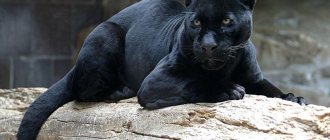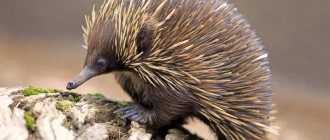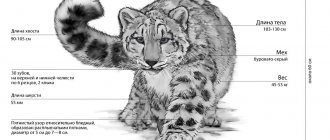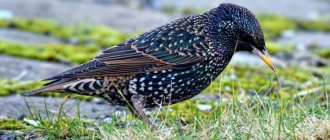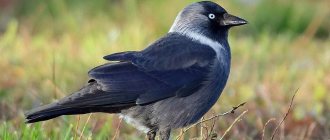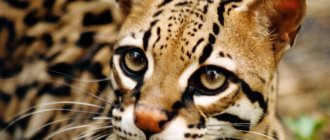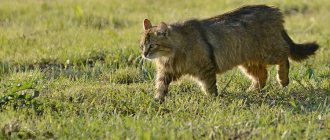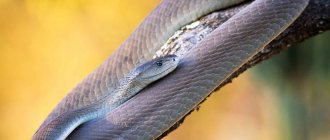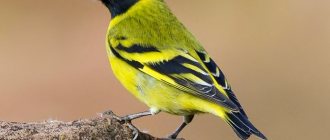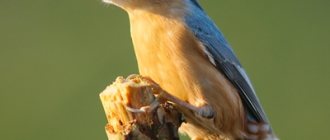The herbivore is a wombat that lives in Australia. In appearance it resembles a small bear; it belongs to the two-incisor marsupials. The wombat resembles the koala, but they are not related.
Unique animals are hunted; they may disappear from our planet, which is why they are listed in the Red Book.
Enemies of wombats
Adult animals have no enemies, but the imported dingo dog is the animal’s enemy.
The back of the rodent's back is like a shield; it is with this that the wombat protects itself. When a dog tries to get into its hole, the wombat waits inside, then tries to corner it or push it against the wall. Then the back shield will strangle the dog.
There have been cases when a wombat crushed a dog's paws against the walls of its hole.
The rodent butts with its powerful head, like a ram (goat). Sometimes males fight, can behave aggressively, moo and shake their heads. There may be fights between injured opponents.
The animal climbs trees very well and can run for a short time at speeds of up to 62 km/h. It quickly burrows into the soil and rests during the day.
Rodents often die under the wheels of cars. Wombats are not afraid of people.
Appearance and lifestyle
An adult wombat is the size of a small bear cub (body length is 0.7 - 1.2 m, and weight is from 20 to 40 kg). These animals are endowed with an incredibly attractive appearance: a plump body covered with thick, coarse hair, short clubbed legs and round button eyes make it irresistible.
Nature has endowed this marsupial with an excellent entrenching tool: its paws have large, strong claws that are convenient for digging the ground. Therefore, the wombat spends most of the day underground, coming to the surface for several hours to eat and sunbathe. The animal’s housing is a “multi-room” burrow-apartment, connected by underground passages.
This is interesting: There is a legend that the copper deposits of Australia were discovered thanks to wombats - people discovered pieces of metal near these animal burrows. Apparently, as a sign of gratitude, the residents of South Wales named one of the villages Wombat, and astronomers gave this name to the Main Belt asteroid.
The corridor tunnels dug by wombats reach 20 m in length and 3.5 m in depth, and the area they occupy can be up to 25 hectares. These representatives of marsupials do not live in flocks, but the burrows of neighboring families are usually located close to each other. Often passages belonging to different families intersect, then the animals use them together.
The wombat is a very slow animal by nature, but in a critical situation it is able to run at the speed of a car - up to 60 km/h, and can swim and climb trees. But in case of danger, he usually hurries to the hole, hides the upper part of his body in it, “plugging” the entrance with a thick loin. And if the enemy nevertheless penetrates the hole, the owner of the home is able to simply strangle him, pressing him against the wall with his powerful, hard butt. Actually, the wombat has practically no natural enemies, with the exception of the thunderstorm of all marsupials in Australia - the dingo dog.
Vombatus is a herbivore; it feeds on grass, plant roots, berries, and mushrooms. It has few teeth, only 12, but the divided upper lip allows it to “cut” grass almost at ground level. Wombats have a very efficient and therefore slow metabolism. It takes them almost 2 weeks to digest food. This animal drinks very little water, only 22 ml per kilogram of weight per day, second only to the camel in terms of economy.
Interesting fact: The wombat's digestive tract is very unusual. In its intestine there are horizontal folds-grooves, so feces are formed in the form of cubes; per day this earth-moving marsupial produces from 80 to 100 dry compact “bricks”. Cube poop does not roll off the surface of a stone or log, which allows the animal to use it as a means of marking territory.
Nutrition
Marsupials have a slow metabolism; any food can be digested for up to 2 weeks.
Among mammals, the wombat is the most economical in terms of water consumption. Per 1 kg of weight - only 22 ml. The unique ability of the animal allows it to survive during periods of drought and in the absence of food.
The animal has a good sense of smell; at night it searches for food, cutting the plant (root crop) at the root with sharp teeth.
The diet of adult rodents is very extensive:
- young shoots of plants;
- roots;
- mushrooms;
- some mosses;
- berries.
Description
Wombats (Vombatidae) are burrowing herbivores that resemble small bears in appearance. Their body length ranges from 70 to 120 cm, weight - from 20 to 45 kg. The body of wombats is compact, the limbs are short and strong. Each of them has five fingers, of which the outer four are crowned with large claws adapted for digging the ground. Wombats have a short tail, their large head gives the impression of being slightly flattened on the sides, and their eyes are small.
It is curious that the wombat's jaws and teeth are similar in structure to rodents. In the upper and lower rows, wombats have a pair of front cutting teeth; The chewing teeth are constructed very simply; there are no angular teeth. Wombats have the fewest teeth among marsupials - 12.
Reproduction
Animals are not particularly fertile, but can reproduce at any favorable time. Only in dry areas - seasonally.
Males reach sexual maturity at 2 years, and females at 3 years.
The animals' pregnancy lasts 20-21 days. After birth, the baby wombat will be in the mother's pouch for 6-8 months. The female has 2 nipples, but she will not be able to feed twins.
A very weak baby wombat clings to the fur and immediately moves into the mother's pouch. Then, having found the nipple, he practically does not tear himself away from it to receive food.
The bag is located on the animal's back, similar to a backpack. This way, when digging holes, no soil will get into the bag.
After 8 months, the baby sometimes begins to leave the pouch and develops muscles. For about a year, the grown-up baby will always be next to his mother until he learns everything.
Methods of protection from the enemy
The back of a wombat's body, made up of thick skin, bones and cartilage, is extremely hard. Thanks to this feature, the marsupial can defend itself from enemies: by turning its back to them, it blocks the entrance to its home. If the enemy managed to get inside, the inhabitant of the holes is able to crush the latter against the walls of the shelter.
A wombat is an animal that, if unable to cope with an enemy, can run away from it, developing a speed of about 40 km/h (for short distances). The marsupial is also capable of climbing trees or swimming.
Wombat character
The wombat is a good-natured animal, but keeping it at home is problematic, because it loves to constantly dig the ground. Animals even reproduce in zoos.
In the wild, rodents live in places that tourists love to visit. Cute animals attract people's attention and are fed with pleasure. Wombats easily make contact and can come close to tourists.
Now it is forbidden to export wombats from the country; large zoos can do so for a substantial sum of 500-1000 dollars.
Where do wombats live?
The habitat of wombats can be called the southern and eastern parts of Australia, the states of South Australia, Victoria, Tasmania, South Wales, and Queensland. The animal spends most of its life underground, so it chooses an area with soil that is well suited for digging holes. The depth of such caves reaches 3 meters, the length of complex tunnel systems is about 20 meters.
Knowing where wombats live, it would be worth mentioning that such animals prefer a solitary lifestyle, but try to place burrows close to each other. For this reason, moves can sometimes intersect.
Diseases
Animals suffer the most from mites; they cause scabies. The disease leads to cracks in the skin, where infection enters. Therefore, after a tick bite, a rodent may even die.
Now Australians are trying to preserve these unique animals in nature and in zoos.
“Little Bears” are the wombats in the photo.
Wombats and people
Despite its appearance, as well as its terrifying fighting abilities, the wombat is very good-natured.
If you tame an animal, it will reward its owner with affection and devotion. They love to be petted.
With a little skill and patience, you can even train a wombat at home.
Despite their fighting qualities, wombats are distinguished by their good-natured disposition. Tamed animals love affection and stroking, getting used to humans quite easily. Local residents often keep wombats as pets. With some diligence, this animal can even be trained! However, it is not recommended to come into close contact with wild animals. A heavy and strong wombat, armed with claws, can pose a danger even to an adult.
The wombat population overall is not declining. However, with the increasing presence of humans on the Australian mainland, a separate species, the Queensland one, almost disappeared. Now there are about a hundred of its representatives living in a specialized reserve in Queensland.
Complete list of Australian animals

